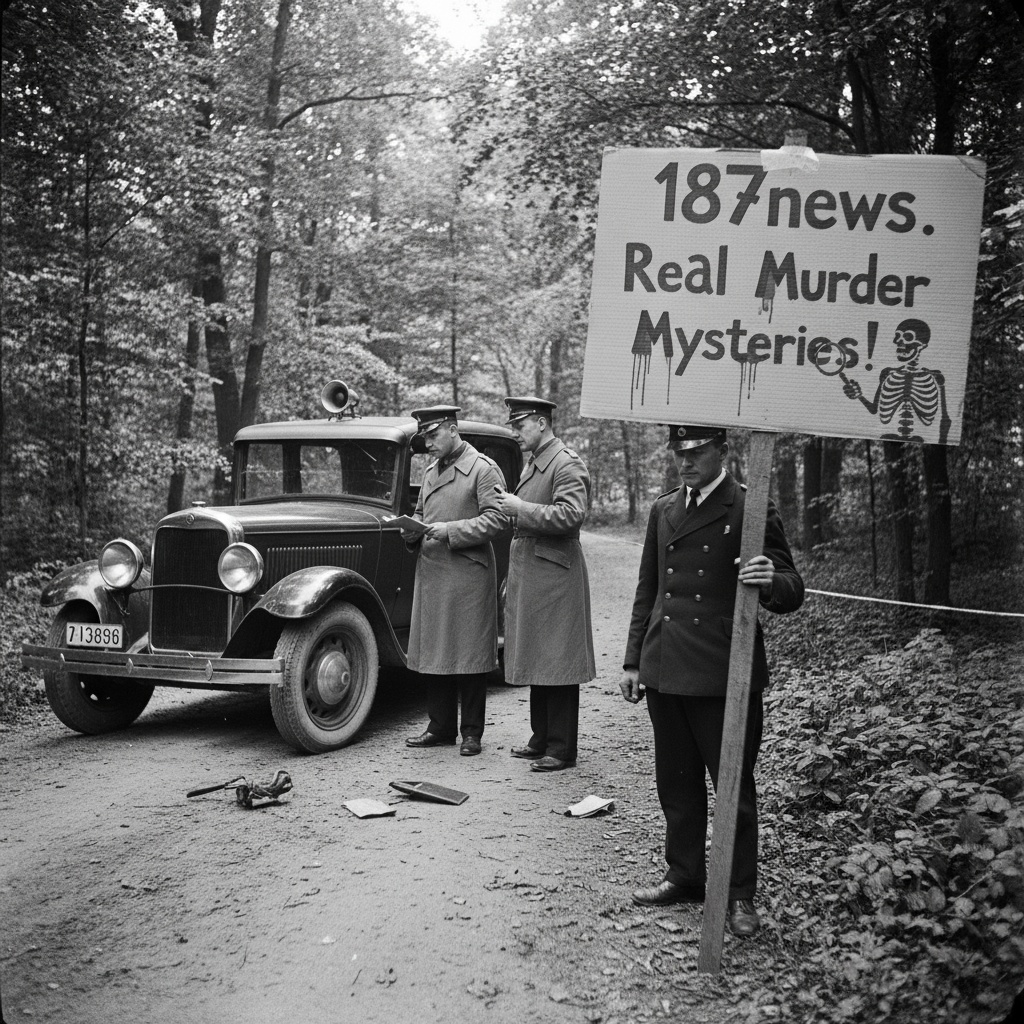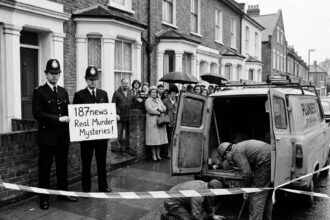One of the first circumstantial evidence trials of the Weimar Republic, which lasted from 1918 to 1933 and saw parliamentary democracy reign in Germany for the first time, was the double murder of Wilhelm Busse and Leopold Werner, who fell victim to a robber-murderer in Heidelberg’s city forest over 100 years ago. On June 27, 1921, the mayor of Herford, Wilhelm Busse, a 50-year-old father of two daughters, traveled from the City Council in Stuttgart to Heidelberg. He had taken up residence at the Hotel Ritter in Heidelberg’s old town. Wilhelm Busse, who had studied law in Heidelberg, wanted to attend the 79th anniversary celebration of the Corps Vandalia Heidelberg, a student fraternity at the Karls-Ruprecht University, together with the former 41-year-old mayor of Herford, Leonard Werner, who had also studied in Heidelberg and had been living in Heidelberg’s Bergstraße since 1919 after retiring due to poor health. After attending the celebration on June 29, 1921, they set off at around 3:30 p.m. on a hike to the Königsstuhl, from which they never returned. Just a few days after their disappearance, without their bodies having been found, railway employee Leonhard Siefert from Ziegelhausen came under suspicion. In the meantime, over 100 police officers combed through the Heidelberg city forest, but to no avail. It was not until July 11, 1921, that two members of the Guestphalia student fraternity discovered the bodies of the two men in the Heidelberg city forest at Linsenteich-Auweg. Wilhelm Busse had been shot from ambush, while Leopold Werner had tried to flee but was killed just 80 meters away. Both had been robbed. A bloodstained postcard with fingerprints was found next to Wilhelm Busse. Leonhard Siefert had his robber’s camp not far from there, and letters from Busse’s wife to her husband were found in the guest room. However, Siefert vigorously denied everything, which is why the public prosecutor’s office was unable to prove his guilt. For this reason, 59-year-old Frankfurt expert Georg Popp, founder of the Institute for Forensic Chemistry and Microscopy in Frankfurt, was brought to Heidelberg to prove Siefert’s guilt in the double murder. The postcard with the fingerprints was one of the most important pieces of evidence. These were left when Siefert stole banknotes from Busse’s wallet. The postcard that Siefert had touched while stealing the cash was also in the wallet and had fallen out, landing next to Busse’s body. In addition, bloodstains and blood spatters were discovered on Siefert’s clothing. Using a method developed by bacteriologist Paul Uhlen in 1901, Georg Popp was able to prove that the bloodstains were definitely human blood. Siefert explained that the stains had been caused during sex with his lover, but this could be refuted. A comparison of the types of moss in the robber’s camp and the flora found stuck to Siefert’s suit also clearly originated from the crime scene. Over 100 witnesses were questioned. On January 16, 1922, Siefert’s trial began at the Heidelberg Regional Court with 12 jurors, who found him guilty after six days of hearings. Siefert denied the crime until the very end. Siefert was sentenced to death by guillotine. On December 19, 1921, a guard found a letter that Siefert had thrown from the second floor of the Heidelberg Old Town Prison, also known as “Fauler Pelz,” in which he asked the finder to take it to his acquaintance, who was supposed to smuggle him tools to escape from prison, Siefert was transferred to Bruchsal that same night because of the risk of escape. There he was executed by guillotine on June 29, 1922. Two engraved red sandstones in Heidelberg’s city forest, donated by a student fraternity, commemorate the two murdered mayors to this day.
The murdered mayors in Heidelberg’s city forest

Tagged:AileenWuornosAktuellesAlpenMysteryAngriffAntiterrorAttentateAutoeinbruchBankenVerbrechenCHBaslerBluttatenBayernKrimiBeklemmendSpannendBerichterstattungBernerMysterienBerühmteFälleDeutschlandBerühmteKriminalfälleBetrugBeweisaufnahmeBjarneMädelBlackDahliaBostonStranglerBRDVerbrechenBreakingNewsBrigitteHeikeBrunoLüdkeCelebrityCrimeCharlesMansonColdCaseColdCaseGermanyColdCasesColdCasesÖsterreichCommunityCrimeSolversCrimeDokuSchweizCrimeNeverSleepsCrimeSceneInvestigationCrimeSolveAttemptCyberCrimeDarknetDatenklauDatenschutzverletzungDDRVerbrechenDerMannimEisDetectiveWorkDetektivarbeitDetektivgeschichteDeutscheGeschichteDeutscheKriminalfälleDeutscherMordfallDiebstahlDigitalDetectivesDNAEvidenceDNARevolutionDrogenhandelnDrogenkartellDrogenkonsumDrogenmissbrauchDrogenschmuggelEchteVerbrechenEdGeinEinbruchEmdenMissbrauchsfallErmittlungenErmittlungsarbeitErmordetEvidentialBreakthroughExtremismusFacebookInvestigatorsFahndungFalcoMordtheorieFamiliendramaCHFanTreffenFemaleCriminalsFinanzbetrugFinanzverbrechenForensicScienceForensikForensikÖsterreichForensischeWissenschaftenFritzHaarmannGefährlicheDamenGefährlicheGifteGeheimnisseDerAlpenGeheimnisvolleVergiftungGeldwäscheGenferKriminalfälleGerechtigkeitGerichtsdramaSchweizGerichtsverfahrenGeschichtsverbrechenGesetzlosigkeitGewaltverbrechenGifteInDerKunstGiftigeRezepturenGiftMordGiftmordGeschichteGladbeckerGeiseldramaGlobalColdCasesGruseligeVerbrechenGruselnMitUnsHackingHamburgTrueCrimeHäuslicheGewaltHerculePoirotHinterkaifeckMordeHistoricalCrimeHistorischeVerbrechenHistorischeVerbrechenCHHistoryLover PastMysteriesIdentitätsdiebstahlInternetbetrugJackTheRipperJackUnterwegerJohnWayneGacyJonBenetRamseyJosefFritzlJugendverbrechenJürgenBartschJustizdramaJustizirrtümerJustizsystemKalteFälleDeutschlandKinderhandelKommissarBeckKommissarDupinKommissarMaigretKommissarWallanderKörperverletzungKreditkartenbetrugKrimiAutorenKrimiBuchKrimiDeutschlandKrimiDokumentationKrimiLiteraturKriminalfälleKriminalgeschichtenKriminalgeschichteÖsterreichKriminalitätNRWKriminalitätsgeschichteKriminalnachrichtenKriminalpolizeiKriminalpräventionKriminalpsychologieKriminalstatistikKriminelleAlchemieKriminologieKrimiPodcastsKrimiSchwarzwaldKrimiSerienKultkriminalfälleKunstraubLebachFallLiveBerichterstattungCHLocalColdCasesMagdaGoebbelsMysteryManfredScharfenorthMenschenhandelMilieuStudienMissbrauchMissingAustriaMissMarpleMittelalterlicheVerbrechenModerneGifteModerneSklavereiModernToxinMordMordfälleMordlustMordundTotschlagMünchenMordMysteriöseFälleMysteriöseTodeMysteriousCaseMysteryInTheUSAMysteryLoverMysteryLoversAustriaNataschaKampuschNaturschutzdeliktNeuesNordicNoirNSUProzessOldCaseNewEvidenceOnlineBetrugOnlineSleuthingOpferhilfeOpferschutzOpferUndTäterOrganisierteKriminalitätÖsterreichMythenPeterKürtenPhilipMarlowePhishingPlünderungPodcastJunkiePolitThrillerSchweizPolizeieinsatzPolizeiruf110ProfilerÖsterreichProfilingPromiSkandalePsychologieDerVerbrechenPsychothrillerRadikalisierungRansomwareRateMitRaubRaubüberfallRauschgiftRechtsmedizinRedditDetectivesRichardRamirezSagenUndMärchenSchuldUndSühneSchweizerKriminalfälleSerienmörderSexhandelSherlockHolmesSicherLebenSpannungPurSpurensucheStarVerbrechenSteirischeVerbrechenStrafrechtSuchtTaschendiebstahlTäterprofileTatortTatortBerlinTatortBremenTatortDeutschlandTatortDortmundTatortGiftfläschchenTatortHistorieTatortKlassikerTatortKölnTatortKommissarTatortKrimiTatortMünchenTatortMünsterTatortsonntagTatortSpekulationenTatortStuttgartTatortuntersuchungTatortWeimarTatortWienTatortZeitTedBundyTerroranschlagTerrorismusTheSodderChildrenThrillerThrillerLesenTimeTravelDetectiveTirolerMysterienTödlicheKulisseTotschlagToxischeWahrheitTrueCrimeAddictTrueCrimeAusstellungenTrueCrimeAutorenTrueCrimeBlogsTrueCrimeBücherTrueCrimeCommunityTrueCrimeDeutschlandTrueCrimeDokuTrueCrimeEventsTrueCrimeFandomTrueCrimeGiftTrueCrimeÖsterreichTrueCrimePodcastTrueCrimePodcastsCHTrueCrimeSchweizTrueCrimeSerieTrueCrimeStoriesTrueCrimeYouTubeUmweltverbrechenUmweltverschmutzungUngeklärteFälleUngeklärteFälleSchweizUnsolvedEuropeUnsolvedMysteryUnterschätztesGiftUrbanLegendsAustriaVandalismusVerboteneLiebeVerbrechenVerbrechenDerMächtigenVerbrechenIm19JahrhundertVerbrechenInBerlinVerbrecheninDeutschlandVerbrechenInWienVerbrechenUndStrafeVerbrechenVonNebenanVerbrecherjagdVergewaltigungVergifteteLiebeVermisstenfälleVersicherungsbetrugVerurteiltDerPodcastVintageCrimeVorsichtGiftWahreVerbrechenWaldbrandstiftungWarumMenschenTötenWildereiWirtschaftskriminalitätZeitVerbrechenZodiacKillerZürcherKrimiZwangsarbeit








